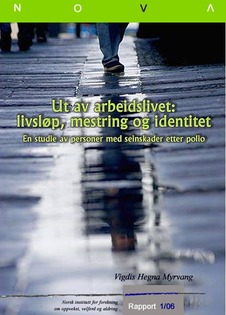| dc.contributor.author | Myrvang, Vigdis Hegna | |
| dc.date.accessioned | 2020-06-07T21:05:16Z | |
| dc.date.accessioned | 2021-04-29T13:57:32Z | |
| dc.date.available | 2020-06-07T21:05:16Z | |
| dc.date.available | 2021-04-29T13:57:32Z | |
| dc.date.issued | 2006 | |
| dc.identifier.isbn | 82-7894-229-3 | |
| dc.identifier.issn | 0808-5013 | |
| dc.identifier.uri | https://hdl.handle.net/20.500.12199/3236 | |
| dc.description.abstract | The main topic of this study is how polio-stricken persons experience the end of working life, early retirement and aging. Why do they leave working life? How do they cope with illness and challenges during the transitional stage from an active working life to existence as a pensioner receiving disablement benefits - long before reaching normal retirement age?The study is based upon qualitative life course interviews with fifteen women and fifteen men between fifty and sixty years old who have new health problems due to their earlier polio. The life course interviews, combined with scientific theories on coping and control, give an insight in how the interviewees interpret their experiences. Theories on self construction and coping are used to obtain an understanding of choices of activity in different situations. Integration of cultural understanding in the perspective of individual development makes clear how individual constructions of identity are influenced by changing external circumstances. The study includes a cultural understanding to show how social and historical conditions have an impact on forming the intervieweesö‚' life course as well as identity, self understanding, coping and choices of activity in the process of retiring on a disability pension.The analytic approach makes it clear that the interviewees to a large extent act out of a mental picture of disabilityö‚' which is related to the medical paradigm and regime of treatment that they grew up with (pathology in the individual body). In this way most of the interviewees take responsibility themselves and continue to push themselves beyond perceived limits to achieve their goals at work as long as possible. Several of them literally collapsed on the spot. The analysis shows that the withdrawal from work is characterized by gender differences. The majority of men go directly from full employment to a disability pension, while womenstep down their work activity in combination with a partial disability pension. In the transition period from being active at work to becoming a disability pensioner the interviewees go through a radical process of reorientation which lead to heavy strains, both physically and psychically. They are forced to change life style and learn how to tackle pain and discomfort in their physically impaired body in new ways. Establishing knowledge, an internalized will to industriousness and perseverance are central coping strategies. Those who are retired create the stigmatized role of a disability pensioner into an activity oriented attitude. They adapt themselves to their personal timeö‚' and begin activities in different arenas of life. It appears that volunteer organizations are of great value for coping and self understanding for those who have left working life; in this way they construct new identities both as organizers and helpers and win new respect in society. The thesis shows that it is the physical impairments combined with working life conditions that lead to end of career. Infrastructure and organizational, physical and other conditions are marginalizing influences. Environmental barriers and a lack of adaption to physical disabilities make the situation difficult. This points out that those demands which working life make on working capacity, productivity and efficiency, to a great extent affect persons with disabilities. Several could have stayed longer in work if their working place had been better adjusted. | en |
| dc.description.abstract | Tema for avhandlingen er uførepensjonering. Hovedspørsmålene er hvorfor personer med seinskader etter polio slutter i arbeidslivet - slik de selv ser det - og hvordan de takler overgangen til å bli uførepensjonister. Undersøkelsen er basert på kvalitative livsløpsintervjuer med femten kvinner og femten menn i alderen femti til seksti år. I undersøkelsen er det anvendt en kulturforståelse i synet på individuell utvikling over livsløpet. Den avdekker hvordan sosiale og historiske forhold har bidratt til å forme livsløpet til intervjupersonene og legge føringer for identitetsarbeid, selvforståelse, mestring og handlingsvalg i pensjoneringsprosessen. Behandlingsideologien under og etter de store polioepidemiene på 1940- og 1950-tallet - som intervjupersonene vokste opp med - la sterk vekt på normalisering og opptrening. Dette medvirket til en personlighetsutrustning hvor utholdenhet og stå-på-vilje var sentrale elementer. Avhandlingen viser at det er de fysiske svekkelsene i kombinasjon med forhold på arbeidsstedet som fører til arbeidslivsslutt. Infrastruktur og organisatoriske forhold, fysiske barrierer og sviktende tilrettelegging bidrar til marginalisering og utstøting. Det peker mot at de kravene som yrkeslivet setter til arbeidsevne, produktivitet og effektivitet, i særlig grad rammer mennesker med funksjonsnedsettelser. Undersøkelsen tyder på at flere kunne stått lenger i arbeid ved bedre tilpasning på arbeidsplassen. | no_NB |
| dc.publisher | Oslo Metropolitan University - OsloMet: NOVA | |
| dc.relation.ispartofseries | NOVA Rapport 1/06 | |
| dc.subject | NOVA | |
| dc.title | Ut av arbeidslivet: livsløp, mestring og identitet | no_NB |
| dc.type | Report | |
| fagarkivet.source.pagenumber | 386 | |
